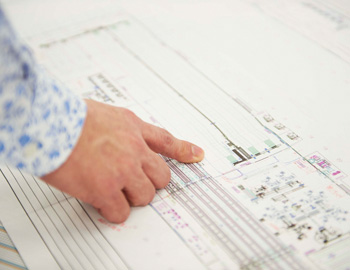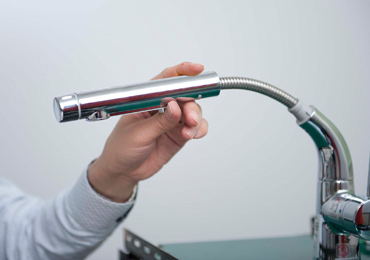

Designing and building the new factory with an unprecedented level of eco-friendliness was a challenging project from stage one.
After graduating from high school, I was employed by TOTO as a factory worker and assigned to the old Shiga Plant building. At the time, I never imagined that I would lead a plant reconstruction project. As it turned out, the project was the largest ever construction in the history of the company, and required that we introduce cutting-edge energy conservation technology to create a "symbolic factory" representing TOTO's environmental efforts. This responsibility was an enormous challenge for me. But my only choice was to just do it, so we established our goal by creating the slogan: "Let's create the world's best sanitary ware factory!"
To achieve this, we first had to innovate the kiln that was consuming 76% of the energy used in the factory, and we set our sights on the very ecological ceramic fiber kiln.
We designed a system that would use waste heat in kiln as well as reusing it in the drying chamber. We also lowered the height of the kiln's interior as much as possible to improve the thermal efficiency.
In addition, we created an ingenious system to place the casting chamber, which has been traditionally located near factory windows, in the center of the building in order to minimize the effects of outside air temperatures. By achieving greater heat insulation capacity, we could also reduce the energy required for air conditioning to a large extent, and by stabilizing room temperatures and moisture levels, we also drastically lowered the ratio of defective products during manufacturing.

New kilns were meticulously redesigned to the size of toilet bowls.

Toilet bowls are fired and cooled in the 111-m long kiln for 15 hours.
When designing each of these details, we kept three key conditions in mind: safety, efficiency and environmental contribution. A plant with three huge kilns at third floor - each 111.36 m long - had never been built anywhere in the world, and we couldn't be sure exactly what would happen when it started operations, even though it had been created based on what we considered to be a perfect design. In fact, as the plant began working, we struggled to deal with precise settings, alterations and adjustments until the plant became stable within one year.

This huge duct recovers waste heat.

The bold decision to arrange pathways and rooms around the molding room contributed to drastically reducing energy.

The individual air-conditioning system keeps the casting room's temperature and humidity stable.
However, the hardest part was for the design team to reach consensus. My team consisted of 12 members, each of whom was an elite worker from TOTO factories all over the country. We were like the "Twelve Samurai," so everyone had a different opinion whenever we tried to decide something. (Laughs). However, We had had to find a solution to building a "symbolic factory", not a conventional factory. So we made dozens of drawings before deciding every issue, and when we couldn't reach a consensus through that process, I, as the leader, made a decision. We repeated this process over and again.
During those tough years, my motivation was supported by the gratitude that I had been given the opportunity to lead such a huge project. In addition, I was firmly convinced that I could create a "dream factory," because I knew the reality of factory work all too well. In fact, among the 12 team members, seven made their ways up from being a factory worker, just as I did. I can firmly say worker's point of view made this factory better.
As a result, we achieved reductions in CO2 emissions of 43%, much higher than the expected target of 30%, and the project was awarded the 2013 Energy Conservation Grand Prix (METI Minister's Prize). The plant has been recognized outside the company as a "symbolic factory" for these environmental efforts. I am very pleased, since I could be involved in a truly historical effort.

The bathroom acts as a model in which visitors can experience Toto's products. The ultra-energy conserving toilet bowl has received much attention.

The factory was entered in the 2013 Energy Conservation Grand Prix for a project for the first time in Toto's history and received the Grand Prix (METI Minister's Prize).











